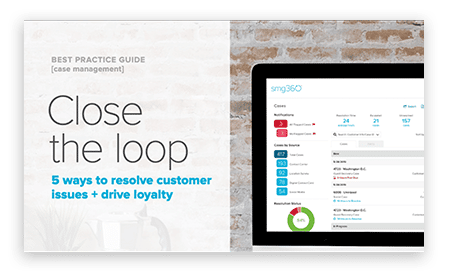5 Ways to Drive Customer Loyalty and Business Outcomes with Case Management
Published on Jul 05, 2022

We get it—your goal is to provide an exemplary experience each time a customer interacts with your brand. But we also understand that sometimes—even with the best of intentions—things can go wrong. And when you’ve got an unhappy customer on your hands, time is of the essence. In fact, most customers expect a resolution to their problem within 24–48 hours. That means you have less than two days to act, resolve their issue, and drive customer loyalty.
So what is your strategy when things go awry? Bury your head in the sand and hope it works out on its own? Ignoring it won’t make the problem go away—it will only make the customer (and their brand loyalty) disappear.
How you step up and handle customer resolution is one of the truest tests of brand resilience. Stuff happens. Experiences fall short. But the truth is, customers can be forgiving—if you have a smart and swift recovery process in place. With an effective close-the-loop system, you can identify customer problems faster, respond immediately, and provide a timely and painless resolution that fosters loyal customers.
Let’s take a look at 5 ways case management can help you resolve customer issues more efficiently:
1. Listen Across All Channels
Customer issues aren’t restricted to any one channel—and your ability to respond quickly is critical no matter the source. But who has the time to sift through them all? Whether it’s a comment from your website, complaints captured through your call center, or issues with online ordering, you need a streamlined case management system that puts them all into one multi-sourced hub of customer feedback.
2. Customize to Your Needs
There is no one-size-fits-all strategy when it comes to providing a consistent customer experience that drives customer loyalty. The process looks different for companies of varying sizes and structure. If you’re having to force your needs into a cookie-cutter plan that doesn’t make sense for your business, your customer recovery strategy will fail. This includes your closed-loop system and how you go about resolving customer issues. With the ability to choose between a more controlled, centralized response system or a more flexible, distributed plan (or even a combination of both), you’ll be sure your closed-loop process is air-tight and effective.

Build stronger customer relationships with these 5 steps
3. Respond In-Platform
Remember what we said about customers expecting a resolution within 1–2 days? An in-platform response system is a great way to make sure you’re not wasting precious time navigating multiple sites. Instead, you’re just a click away from contacting your customer and that much closer to resolving the issue.
In-platform response templates don’t just provide a quick response—they can also deliver a personal message. Editable templates allow the user to customize as needed so customers always get messages that are both consistent yet personal, and don’t feel like they’re just getting a blanket response. This level of human connection is even more important now—today’s customers expect brands to be empathetic to their needs and those that do will win out over competitors.
Templates also help drive consistent, on-brand messaging and create a united front in customer recovery. Employees won’t have to reference company guideline standards before responding, and all customer communication will be quick, consistent, and transparent—resulting in happy customers and their repeat business.
4. Track Progress
We mentioned you’re up against the clock when it comes to resolving customer issues. In fact, it’s best practice to resolve a problem within 24–48 hours of being contacted. In order to stay on-goal, all conversations need to be tracked through a case management platform, so you can keep an eye on progress and see it through to final resolution. Time-to-resolve metrics help you and your team stay on track to be sure each case is being resolved promptly.
And if it’s necessary to reassign the case, it should be simple to switch. Re-route the resolution where it needs to go quickly (i.e., reassign to a location manager if a problem has escalated or re-route the alert if it went to the wrong location). That way the case is always in the right hands.
5. Create Front-Line Impact
Obviously the main benefit of successfully resolving a customer issue is pleasing the consumer and improving customer satisfaction. But a secondary perk is that case management also provides transparency into your service recovery efforts. This gives you a clearer picture of where you are succeeding and where your efforts should be directed. Does your team need to work on quicker response times? Or is there a gap in communication where actions are falling through the cracks?
Use case management reporting to pull stats to share with your team and drive engagement across your organization. Take this opportunity to learn from successes and shortcomings and drum up excitement to improve.
Implement Case Management or Risk Losing Loyalty
Don’t hide from customer problems. When an experience falls short with a customer, it’s actually a great opportunity to gain their loyalty. Our data shows 84% of customers who are highly satisfied with problem resolution express a high likelihood to return to the business. Get a strategy in place to set your brand up for successful guest recovery. Case management will help you build stronger customer relationships, improve customer retention, and drive business outcomes.
To learn more on how to close the loop with best-in-class capabilities, request a demo or watch this video.
Related articles

Convenience store traffic: 3 of the latest consumer trends you need to know
Informed by real-world data, these 3 CX convenience store trends map the customer traffic patterns and expectations to know so stores can drive loyalty in 2023.

Power play: Unleashing the combined force of a unified customer and employee experience management strategy
Discover the power of integrating employee + customer experience data, and learn how prioritizing employee experience leads to engaged team members, loyal customers, + business success.

How understanding the customer journey elevates customer experience
Discover how understanding and optimizing each phase of the customer journey—from awareness to advocacy—can elevate your customer experience strategy, build loyalty, and drive conversions. Learn actio